Trap Cultures
Trapping AM fungi can be used to obtain many healthy spores of colonizing fungi for identification, as inoculum to establish monospecific cultures, or for experiments. Spores collected directly from field soil suffer from many problems: (a) they appear healthy but are not viable (some persisting as dead husks for years or possibly decades), (b) they lose or change appearance of their structural characters in response to root pigments, soil chemistry, temperature, moisture, and microbial activity, and they represent only those colonizing arbuscular fungi with enough activity and biomass to trigger sporulation.
Trap cultures yield very different results, depending on all of the biotic and abiotic factors that go into growth, reproduction, and the partitioning of colonization and sporulation. Our experience indicates when species richness is high and colonization by all members of the assemblage is relatively low (e.g., arid environments), most if not all indigenous fungi will sporulate after 2-3 successive propagation cycles (Stutz & Morton 1996). When species richness and colonization are both moderate to high, often only the most aggressive species will sporulate and 2-3 successive propagation cycles could have the opposite effect of yielding just 1-2 sporulating species. Levels of sporulation of AM fungal species can also depend upon host plant identity (Bever et al. 1996).
We consider trap cultures to be important in the following situations:
When mycorrhizae are clearly present in roots of a plant community, but little or no sporulation occurs (a common condition in many arid and hydric sites).
Sites where the soil is high in microbial activity, especially those in tropical environments (high temperature, moisture) and those with high organic matter. In these environments, a high proportion of spores undergo so much structural change or degradation that discovery and identification of species is difficult to impossible.
When the objective is to obtain abundant healthy spores of different species and establish monospecific cultures for various research problems or to develop “custom inoculum” consisting of well-defined species mixtures.
Method
Rhizosphere soil (attached to roots and dug up with a shovel or some other tool) is collected. A root ball is ideal. Shoots are removed at the crown and roots are chopped into small fragments and mixed thoroughly with the associated soil using an ax or some other cutting utensil.
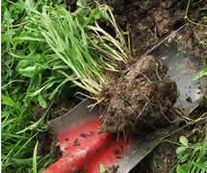
Chopped Blend
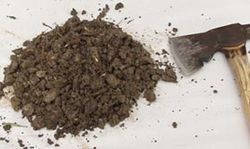 This chopped blend is mixed 1:1 (v/v) with autoclaved coarse sand. We use gallon zip-loc bags for the mixing process, because it is easy to “massage” the bag to break up small clumps of soil or roots and improve chances for a homogeneous product. This mix then is transferred to a 15-cm plastic pot. Smaller pot sizes should be avoided if possible (especially cone-tainers), because roots fill the volume too quickly, quit growing, and increase competition among species for limited root substrate. Larger pots also work well, but optimal sporulation takes longer (our hypothesis of the basis for this).
This chopped blend is mixed 1:1 (v/v) with autoclaved coarse sand. We use gallon zip-loc bags for the mixing process, because it is easy to “massage” the bag to break up small clumps of soil or roots and improve chances for a homogeneous product. This mix then is transferred to a 15-cm plastic pot. Smaller pot sizes should be avoided if possible (especially cone-tainers), because roots fill the volume too quickly, quit growing, and increase competition among species for limited root substrate. Larger pots also work well, but optimal sporulation takes longer (our hypothesis of the basis for this).
Seed Pots
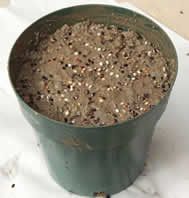 Seed pots with a highly dependent C4 grass. We over-seed (80-100 seeds/pot) for a variety of reasons (explanation). Other hosts can be used, but care must be taken to avoid coarse or sparsely rooted species (which may be wonderful for single species) because they have more constrained niche space that is likely to exclude slow-growing fungal species.
Seed pots with a highly dependent C4 grass. We over-seed (80-100 seeds/pot) for a variety of reasons (explanation). Other hosts can be used, but care must be taken to avoid coarse or sparsely rooted species (which may be wonderful for single species) because they have more constrained niche space that is likely to exclude slow-growing fungal species.
Cultures Grown in Greenhouse or Growth Rooms
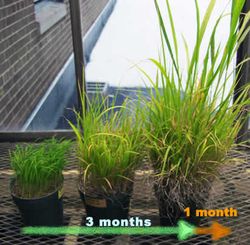 Cultures are grown in a greenhouse or growth room for at least four months. Some sporulation occurs during the first three months, but it is during the fourth month when plant shoots (and roots) have ceased growth and carbon seems to be repartitioned to sporulation rather than mycorrhizal development. A longer time often is undesirable because other fungi often colonize the cultures which can lead to hyperparasitism and poorer conditions for dry storage. Fertilization is kept to a minimum, being applied only when plants show signs of phosphorus deficiencies (purpling of leaf sheaths), or nitrogen deficiency (chlorosis of young leaves).
Cultures are grown in a greenhouse or growth room for at least four months. Some sporulation occurs during the first three months, but it is during the fourth month when plant shoots (and roots) have ceased growth and carbon seems to be repartitioned to sporulation rather than mycorrhizal development. A longer time often is undesirable because other fungi often colonize the cultures which can lead to hyperparasitism and poorer conditions for dry storage. Fertilization is kept to a minimum, being applied only when plants show signs of phosphorus deficiencies (purpling of leaf sheaths), or nitrogen deficiency (chlorosis of young leaves).
Drying Period
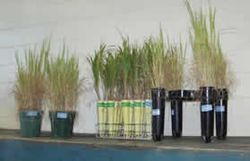 Pots are left to dry undisturbed in a shaded room with a fairly stable temperature so that the drying period is not too rapid (1-2 weeks).
Pots are left to dry undisturbed in a shaded room with a fairly stable temperature so that the drying period is not too rapid (1-2 weeks).
Spores should be extracted before pot contents are dry to obtain the brightest and cleanest specimens. If there is any chance that spores are to be collected to set up monospecific cultures within 3 months of harvest, we generally only dry long enough to eliminate free moisture when contents are bagged (to be sure again of retrieving highly infective propagules).
Cultures Stored in Gallon Zip-loc Bags
All trap cultures are stored in gallon zip-loc plastic bags for at least 30 days before spores are extracted for inoculation onto seedlings. Spores of many species (particularly those in Acaulospora and Entrophospora) appear to require a dormancy period before they are infective, but this can vary with habitat. The 30-day rest period appears to reduce or eliminate this variable.
For trap cultures that are to be propagated for 1-2 additional cycles, the bagged material is used as inoculum (undiluted) and set up within 30 days of harvest. If sporulation is extremely low, then the pots aren’t harvested, but shoots removed and the pot contents reseeded.
Reference
- Bever, J. D., Morton, J. B., Antonovics, J., & Schultz, P. A. 1996. Host-dependent sporulation and species diversity of arbuscular mycorrhizal fungi in a mown grassland. Journal of Ecology. 84: 71-82.
- Stutz, J. C., & Morton, J. B. (1996). Successive pot cultures reveal high species richness of arbuscular endomycorrhizal fungi in arid ecosystems. Canadian Journal of Botany.74: 1883-1889.